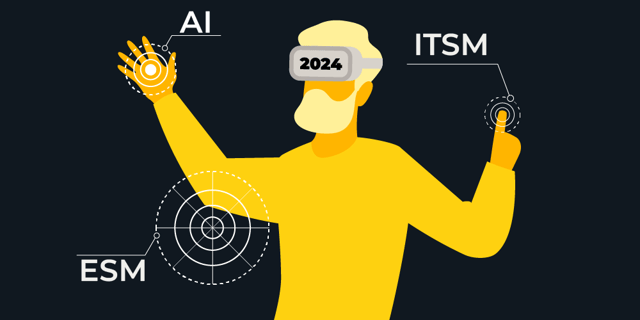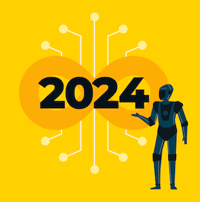ITSM and ESM trends to look out for in 2024

Today, organizations rely heavily on technology to operate efficiently and deliver seamless services to their customers, which has led to the emergence of two disciplines—Information Technology Service Management (ITSM) and Enterprise Service Management (ESM).
ITSM focuses on optimizing the delivery of IT services within an organization, making sure that systems and infrastructure support processes and meet user needs. ESM, on the other hand, extends the principles of ITSM to encompass all the services of an organization, regardless of whether they are IT-related or not. This holistic approach enables organizations to manage and optimize the delivery of all the services they offer so that they are aligned with business goals and delivered to the highest standard.
As we move into 2024, both ITSM and ESM are up for significant transformation, driven by the rapid development of technologies, the growing complexity of IT environments, and the demand for exceptional user experiences (shift-left). To navigate this transformative year effectively, we must keep up with emerging trends and invest in innovative solutions that improve service delivery and the user experience, and fulfill business objectives.
Key trends shaping ITSM and ESM in 2024
1. Automation and AI-driven service delivery
Automation and artificial intelligence (AI) are set to play a more prominent role in ITSM and ESM in 2024. Organizations are increasingly adopting robotic process automation (RPA) and chatbots to streamline repetitive tasks, freeing up IT staff to focus on more strategic initiatives. AI is also being leveraged to analyze large volumes of data, identify trends, and predict potential issues for proactive service management and improved decision-making.
2. Cloud-based ITSM and ESM solutions
The adoption of cloud-based ITSM and ESM solutions is accelerating, driven by their scalability, flexibility, and cost-effectiveness. Cloud platforms offer a centralized hub for managing IT operations, giving organizations the agility to respond to changing business needs. Cloud-based solutions also allow seamless collaboration among distributed teams for consistent service delivery.
3. Hybrid IT and multi-cloud management
As organizations embrace hybrid and multi-cloud environments, the need for robust ITSM and ESM solutions that can be managed across multiple platforms is becoming paramount. These solutions should provide a unified view of IT assets, services, and processes, allowing organizations to efficiently manage their IT infrastructure and deliver consistent services to users.
4. User experience (UX) enhancement
The focus on providing exceptional user experiences is transcending traditional IT boundaries, extending to ITSM and ESM. Organizations are recognizing the importance of creating self-service portals, chatbots, and other user-friendly interfaces that empower users to solve problems and resolve issues quickly.
5. Security and risk management
Security remains a priority for organizations, and ITSM and ESM play a critical role in mitigating cyber threats and protecting sensitive data. Organizations are adopting security orchestration, automation, and response (SOAR) solutions that integrate security tools and automate incident response processes.
6. Data-driven insights and analytics
Data analytics is becoming increasingly valuable in ITSM and ESM, giving organizations valuable insights into IT performance, user behavior, and service delivery issues. These insights can be used to identify trends, optimize processes, and proactively address problems.
7. People management and collaboration
While technology is driving many of the changes in ITSM and ESM, the role of people remains essential. Organizations are focusing on creating a culture of collaboration, empowering IT teams to share knowledge, learn from each other, and continuously improve their service delivery practices.
8. Sustainability and environmental impact
Sustainability is becoming a key consideration for organizations, and ITSM and ESM can help reduce the environmental impact of IT operations. Adopting cloud-based solutions, optimizing resource utilization, and minimizing data center energy consumption are just a few examples of how organizations can make a positive change.
9. Continuous improvement and innovation
In today's dynamic IT landscape, we need to embrace continuous improvement and innovation to stay ahead of the curve. Adopting agile methodologies, experimenting with new technologies, and fostering a culture of innovation will be essential for organizations to thrive in the years to come.
When and if your organization adopts some of these trends, you can effectively manage your IT operations and deliver exceptional service experiences.
As we move into 2024, ITSM and ESM will play a significant role in driving success in the ever-evolving digital world.
Published:
Updated:


